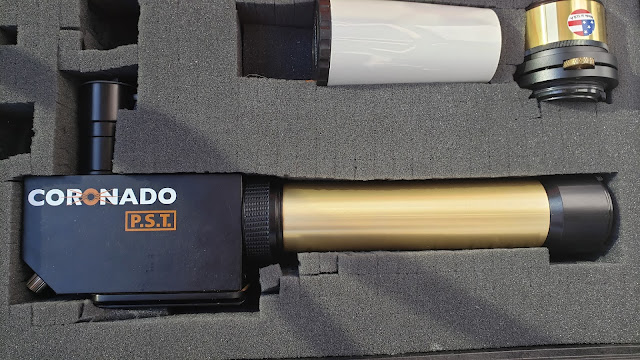Itty Bitty Radio Telescope First Sun Tests and Measurements
I wanted to test out my Itty Bitty Radio Telescope on the Sun. I have not yet fully sorted out the interface to the computer for data logging, but I decided to test my telescope out to finally get some type of result from it.
I set the Satellite Dish outside and attached the cable to one of the supports using some zip ties. I used my handy scale on the altitude adjustment rod to quickly get my dish pointed at the Sun.
I then wrapped a microphone from a headset of mine around my Satellite Finder and plugged the headset into my computer.
I then used a program called Radio Sky-pipe to record the results. It is really good at producing strip charts and it is pretty easy to use.
I loaded up Radio Sky-pipe and observed the results on screen in real time as I adjusted the dB knob to test the sensitivity. As the reading on the Satellite Finder meter varies, the frequency of the buzzer adjusts with varying signal strength, not the volume of the sound Radio Sky-pipe could not tell the difference between a weak signal and a strong signal because it measures signal strength, not frequency. Because of this, I will not be able to do a true measurement of the 3 dB beam-width of my telescope, but I can get an idea of how much sky the telescope can sense a signal in because all I will be able to sense is if my telescope is sensing something, not how strong that return is.
In order to measure signal strength using the Satellite Finder, I would have to record and log the DC voltages used to run the meter.
I pointed my telescope just off the Sun, and started Radio Sky-pipe recording as the Sun moved across the telescope. I did this three times to get a bit of an average reading. Posted below are my three measurements.
The first and last test sensed signal for approximately twenty three minutes each time. The second test came in at a much shorter time of ten minutes. I don't know what happened with the second test.
Assuming the Sun moves at an average of 15 degrees per hour, the first and third test sensed signal for 5.75 degrees on average. The second test sensed signal for 2.5 degrees.
Quite a difference, but still a large section of the sky. It is really nice to be able to get some signals finally from the telescope. It seems to be picking up returns from the Sun no problem. The setup just needs a few refinements.
I am really interested in the 3 dB beam-width. Next step is integrate the returned signal proportional to signal strength with some logging software to do more detailed measurements.
I set the Satellite Dish outside and attached the cable to one of the supports using some zip ties. I used my handy scale on the altitude adjustment rod to quickly get my dish pointed at the Sun.
 |
| Dish pointed at the Sun |
I then wrapped a microphone from a headset of mine around my Satellite Finder and plugged the headset into my computer.
 |
| Microphone wrapped around Satellite Finder |
I loaded up Radio Sky-pipe and observed the results on screen in real time as I adjusted the dB knob to test the sensitivity. As the reading on the Satellite Finder meter varies, the frequency of the buzzer adjusts with varying signal strength, not the volume of the sound Radio Sky-pipe could not tell the difference between a weak signal and a strong signal because it measures signal strength, not frequency. Because of this, I will not be able to do a true measurement of the 3 dB beam-width of my telescope, but I can get an idea of how much sky the telescope can sense a signal in because all I will be able to sense is if my telescope is sensing something, not how strong that return is.
In order to measure signal strength using the Satellite Finder, I would have to record and log the DC voltages used to run the meter.
I pointed my telescope just off the Sun, and started Radio Sky-pipe recording as the Sun moved across the telescope. I did this three times to get a bit of an average reading. Posted below are my three measurements.
 |
| Beam Test One |
 |
| Beam Test Two |
 |
| Beam Test Three |
The first and last test sensed signal for approximately twenty three minutes each time. The second test came in at a much shorter time of ten minutes. I don't know what happened with the second test.
Assuming the Sun moves at an average of 15 degrees per hour, the first and third test sensed signal for 5.75 degrees on average. The second test sensed signal for 2.5 degrees.
Quite a difference, but still a large section of the sky. It is really nice to be able to get some signals finally from the telescope. It seems to be picking up returns from the Sun no problem. The setup just needs a few refinements.
I am really interested in the 3 dB beam-width. Next step is integrate the returned signal proportional to signal strength with some logging software to do more detailed measurements.

Comments
Post a Comment